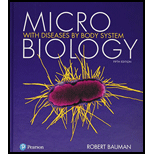
Concept explainers
To tell:
Why the mucous membrane barriers and skin of the body are not the significant factors in your resistance to infection by hyper thermophiles?
Introduction:
The skin and mucous membrane are the most effective barriers to the infection. The surface of the skin inhibits the growth of the microorganism because of low pH and moisture. The innate immune response against the pathogen includes the skin and mucus and the skin is composed of epidermis and dermis. There are several layers which are tightly packed in cells. Epidermal dendritic cells have phagocytized the pathogens. However, the mucous membrane has two layers of epithelial cells and dendritic cells. Epithelial cells are tightly packed which prevents the entry of pathogens. The first line of defense in the body acts against the pathogens by antimicrobial peptides which are produced by the skin and mucous membrane eliminates the microbes.
Explanation of Solution
Hyper thermophile is the organism which lives in an extremely hot environmentof 60°C to 80°C. The human body is naturally resistant to the hyper thermophiles infection because the body temperature of humans is low. It is very difficult for the growth of hyper thermophiles.
Hence, the skin and mucous barrier are not a significant factor for protecting the body from the infection by hyper thermophiles.
Want to see more full solutions like this?
Chapter 15 Solutions
Microbiology with Diseases by Body System (5th Edition)
- Which of the following is an example of a chemical barrier to infection? Cellular junctions Mucosal membranes Defensins O Skinarrow_forwardWhat feature of the skin creates a physical barrier to microbial invasion? Group of answer choices The outer layers are composed of cells full of protein which forms NETs to trap microbes until they are shed. The surface is constantly patrolled by phagocytic cells. The outer layers are dead cells, tightly linked together, and are frequently shed. All of these mechanisms can provide defense against microbial invaders. The oil secreted onto the surface of the skin traps microbes, preventing penetration. The fine hairs move microbes to mucous membranes for phagocytosis.arrow_forwardIncrease in body temperature should increase the rate of metabolism of microbes instead of killing them. How does a fever helps our bodies fight infection?arrow_forward
- 4) A patient has their spleen removed due to an accident. How will this affect the immune response? 5) You come in contact with staphylococci through a cut. What cellular features will the immune cells recognize? 6) Name two opsonins and how do these molecules help the immune response? 7) Fever is part of the inflammatory process. What is the role of fever during an immune response? 8) This chemical is used to induce anti-viral responses in cells to protect the cells from viral infections. 9) This complement activation pathway is activated when complement binds to an antibody bound to antigens.arrow_forwardWhat do you mean by chemotropism?arrow_forwardWhich of the following is a barrier against pathogens provided by the skin? a. low pH b. mucus c. tears d. ciliaarrow_forward
- Which of the following is not an example of the physical, mechanical, and chemical barriers at body surfaces that prevent most microbes from entering the internal environment? Phagocytosis by white blood cells The thick waterproof layer of dead cells that make up the skin The flushing action of urination Sticky mucus secreted by the epithelial tissues of the body's interiorarrow_forwardHyaluronidase and collagenase both allow bacteria to _____. View Available Hint(s) for Part A adhere to body cells invade a host's tissues escape detection by a host interfere with complementarrow_forwardWhich of the following is not an example of the physical, mechanical, and chemical barriers at body surfaces that prevent most microbes from entering the internal environment? The flushing action of urination Sticky mucus secreted by the epithelial tissues of the body's interior Phagocytosis by white blood cells The thick waterproof layer of dead cells that make up the skinarrow_forward
- Which is NOT a role of sebum in the innate immune system. Group of answer choices dehydrates microbes keeps skin pliable and less likely to tear contains antimicrobial proteins lowers pHarrow_forwardGram negative bacteria posseses a lipopolysaccharide (LPS) layer. how does this structural feature interact with human immune system?arrow_forwardThe dead outer surface of skin (not mucous membranes) uses which of the following innate defenses to inhibit microbial growth? Choose all that apply. Group of answer choices Prion production Interferon production Low pH Drynessarrow_forward
 Principles Of Radiographic Imaging: An Art And A ...Health & NutritionISBN:9781337711067Author:Richard R. Carlton, Arlene M. Adler, Vesna BalacPublisher:Cengage Learning
Principles Of Radiographic Imaging: An Art And A ...Health & NutritionISBN:9781337711067Author:Richard R. Carlton, Arlene M. Adler, Vesna BalacPublisher:Cengage Learning Concepts of BiologyBiologyISBN:9781938168116Author:Samantha Fowler, Rebecca Roush, James WisePublisher:OpenStax College
Concepts of BiologyBiologyISBN:9781938168116Author:Samantha Fowler, Rebecca Roush, James WisePublisher:OpenStax College Human Physiology: From Cells to Systems (MindTap ...BiologyISBN:9781285866932Author:Lauralee SherwoodPublisher:Cengage Learning
Human Physiology: From Cells to Systems (MindTap ...BiologyISBN:9781285866932Author:Lauralee SherwoodPublisher:Cengage Learning


